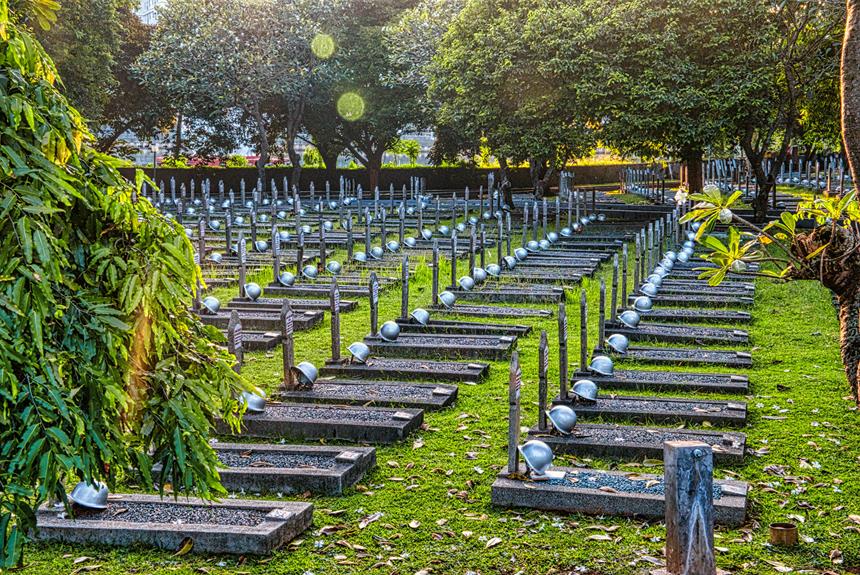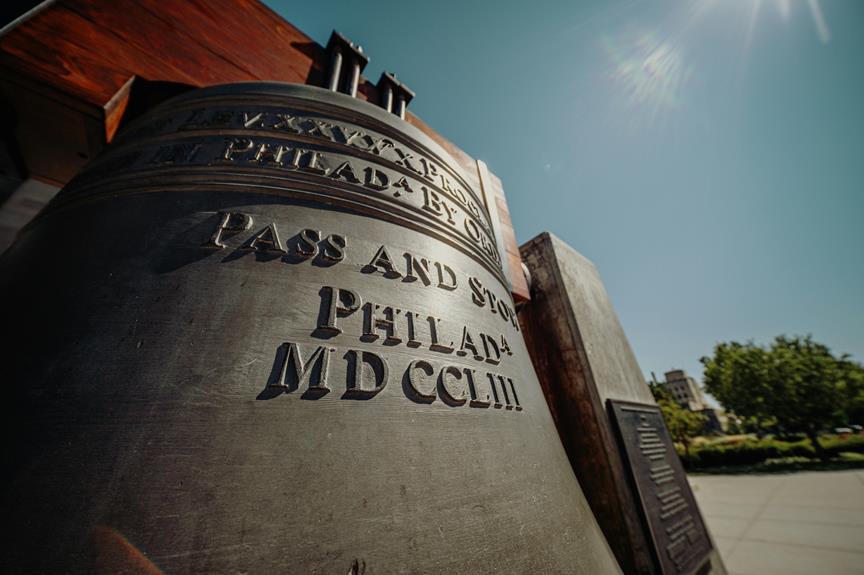Yad Vashem, located in Israel, is a place of profound significance, honoring the memory of the millions who perished in the Holocaust with dignity and respect. Beyond its role as a memorial, Yad Vashem also serves as a hub for research, education, and commemoration. The architectural design and symbolic spaces within Yad Vashem evoke a sense of solemnity and contemplation, inviting visitors to connect with history on a deeply personal level. As a symbol of remembrance and a demonstration of resilience, Yad Vashem's impact extends far beyond its physical walls, leaving a lasting impression on all who visit.
Key Takeaways
- Yad Vashem is a memorial in Israel commemorating Holocaust victims.
- It serves as a research, education, and remembrance center.
- The architecture conveys solemnity and hope through modern design.
- Yad Vashem features memorials like the Hall of Names and Children's Memorial.
- The institution preserves history, educates about the Holocaust, and honors victims' memory.
History of Yad Vashem
Established in 1953, the history of Yad Vashem, Israel's official memorial to the victims of the Holocaust, is a poignant narrative that commemorates the atrocities of World War II and honors the memory of the six million Jewish victims. The origins of Yad Vashem can be traced back to the aftermath of the war when the magnitude of the Holocaust's horrors became clear. The name 'Yad Vashem' is derived from a biblical verse meaning 'a place and a name,' symbolizing the importance of remembering the victims not just as a faceless mass but as individuals with stories and lives.
The significance of Yad Vashem lies not only in its role as a memorial but also as a center for research and education. It serves as a repository of the memories of those who perished, with its vast collection of artifacts, documents, and testimonies. Through its various exhibits and educational programs, Yad Vashem aims to make certain that the lessons of the Holocaust are not forgotten and that future generations are equipped to combat hatred and intolerance.
Yad Vashem stands as a beacon of remembrance and resilience, a proof to the enduring human spirit in the face of unspeakable evil. It serves as a reminder of the consequences of unchecked hatred and bigotry, urging visitors to reflect on the past and work towards a future built on empathy, understanding, and freedom.
Architecture and Layout
The design and layout of Yad Vashem, Israel's memorial to the Holocaust victims, intricately reflect the solemnity and reverence of its purpose, embodying a profound tribute to the memory of those lost. The architecture of Yad Vashem incorporates modern design elements that evoke a sense of contemplation and remembrance. The stark lines and minimalist aesthetic of the buildings create a somber atmosphere, guiding visitors through a journey of reflection and honoring the victims of one of history's darkest chapters.
Yad Vashem's layout is carefully planned to offer visitors symbolic spaces that facilitate both individual introspection and collective mourning. The Memorial Hall, with its cavernous interior and symbolic lighting, serves as a central focal point for commemoration. Surrounding gardens and walkways provide peaceful areas for contemplation, allowing visitors to process the weight of history in a tranquil setting.
The architectural design of Yad Vashem not only honors the memory of the Holocaust victims but also conveys a message of resilience and hope. Through its modern aesthetic and thoughtful layout, Yad Vashem stands as a tribute to the enduring strength of the human spirit in the face of unimaginable tragedy.
The Hall of Names
Within the solemn walls of Yad Vashem, the Hall of Names stands as a poignant repository of memory and tribute to the millions who perished in the Holocaust. This sacred space serves as a memorial tribute to the victims, preserving their names and stories for future generations. The Hall of Names is a place of remembrance and reflection, where visitors can pay their respects and honor the memories of those who suffered unimaginable atrocities.
- Ceiling of Names: The ceiling is covered with photographs of Holocaust victims, symbolizing the vast number of lives lost during that dark period in history.
- Circular Repository: In the center of the hall lies a circular repository containing Pages of Testimony, each documenting the life and fate of an individual who perished in the Holocaust.
- Interactive Displays: Interactive displays allow visitors to access the Yad Vashem database for genealogy research, enabling them to trace their roots and discover more about their family's history.
- Eternal Flame: An eternal flame burns in the Hall of Names, symbolizing the enduring memory of the victims and the hope for a brighter future free from hatred and intolerance.
The Hall of Names serves as a powerful reminder of the human cost of hatred and discrimination, urging us to never forget the past and to work towards a more inclusive and compassionate world.
Children's Memorial
Nestled within Yad Vashem, the Children's Memorial stands as a significant tribute to the young lives lost during the Holocaust, evoking a profound sense of remembrance and reflection. The architectural design of the memorial plays an important role in enhancing its emotional impact on visitors.
As one enters the memorial, they are enveloped in darkness, symbolizing the darkness of the Holocaust era. The only source of light comes from the flickering flames of countless candles reflected in an infinite number of mirrors, representing the lost souls of approximately 1.5 million children who perished.
The structure's simplicity and lack of individual names or stories focus on the collective loss and tragedy suffered by children during that horrific period in history. The immersive experience created by the memorial's design allows visitors to connect on a deeply emotional level, fostering empathy and understanding.
The Children's Memorial serves as a poignant reminder of the innocence snatched away too soon and the unimaginable suffering endured by the young victims. It stands as a demonstration to the importance of preserving their memory and ensuring that future generations never forget the atrocities of the Holocaust.
Through its powerful combination of memorial architecture and emotional symbolism, the Children's Memorial at Yad Vashem continues to honor the lives of the children who were taken too soon.
Righteous Among the Nations
Among the stories of heroism and compassion that emerged from the darkness of the Holocaust, the individuals recognized as Righteous Among the Nations shine as beacons of humanity's capacity for selfless courage and moral integrity. These heroic individuals risked their lives to rescue Jews from the atrocities of the Nazis, standing up against tyranny and injustice in the face of grave danger. The actions of the Righteous Among the Nations serve as a reminder of the power of empathy and the strength of the human spirit in the most challenging of times.
- Courageous Acts: These brave individuals displayed extraordinary courage in the face of unimaginable horrors, choosing to do what was right even when it meant going against the norms of society.
- Selfless Sacrifice: The Righteous Among the Nations put the lives of others before their own, demonstrating a level of selflessness that is truly inspiring.
- Moral Compass: Despite the prevailing darkness and despair, these individuals held onto their moral compass, guided by principles of justice and compassion.
- Legacy of Hope: The legacy of the Righteous Among the Nations serves as a beacon of hope, reminding us that even in the darkest of times, there are those who will rise above adversity to do what is just and humane.
Artifacts and Exhibits
In the historical narrative of Yad Vashem, Israel, the artifacts and exhibits stand as tangible evidence to the experiences and resilience of those impacted by the Holocaust. Each artifact within Yad Vashem's collection holds a profound story, serving as a link to the past and a confirmation to the lives that were forever altered. These artifacts, ranging from personal items like clothing and letters to larger objects such as train cars and concentration camp uniforms, provide visitors with a visceral connection to the individuals who endured unimaginable suffering during this dark period in history.
The preservation techniques employed at Yad Vashem are meticulous and essential in ensuring that these artifacts retain their integrity for future generations to witness. Climate-controlled environments, specialized lighting, and careful handling procedures are all part of Yad Vashem's commitment to safeguarding these invaluable pieces of history. By employing advanced preservation methods, Yad Vashem not only honors the memory of those who perished but also educates visitors about the atrocities of the Holocaust in a respectful and impactful manner.
Each exhibit within Yad Vashem is thoughtfully curated to evoke emotions and provoke contemplation. The deliberate arrangement of artifacts and accompanying narratives creates a somber yet enlightening journey through history, leaving a lasting impression on all who pass through its halls. Through the careful preservation and thoughtful presentation of these artifacts, Yad Vashem ensures that the voices of the past continue to be heard, ensuring that the lessons of the Holocaust are never forgotten.
Research and Documentation
With meticulous attention to detail and unwavering dedication, the research and documentation efforts at Yad Vashem in Israel serve as a cornerstone in preserving and disseminating the historical truths of the Holocaust. The institution employs various research methods and preservation techniques to guarantee that the memory of the victims lives on and that future generations can learn from the atrocities committed during World War II.
- Oral Histories: Yad Vashem conducts interviews with survivors, witnesses, and descendants to capture firsthand accounts of the Holocaust, providing a human voice to the historical narrative.
- Archival Research: Through meticulous examination of documents, letters, and photographs, researchers piece together the stories of individuals and communities affected by the Holocaust, shedding light on their experiences.
- Digital Preservation: Utilizing advanced technologies, Yad Vashem digitizes and archives historical materials, safeguarding their long-term preservation and accessibility for researchers and the public.
- Cross-referencing: By cross-referencing different sources of information, Yad Vashem verifies the accuracy of historical data, contributing to the integrity and reliability of its research findings.
Through these research methods and preservation techniques, Yad Vashem fulfills its mission of commemorating the victims of the Holocaust, educating the public about this dark chapter in history, and advocating for a world free from hatred and discrimination.
Educational Programs
Exploring the intricate tapestry of historical remembrance, Yad Vashem in Israel carefully crafts educational programs that illuminate the dark shadows of the Holocaust with unwavering dedication. The educational programs at Yad Vashem are designed to provide thorough Holocaust education through interactive experiences that guarantee the lessons of history are not forgotten. These programs are enriched with survivor testimonies, allowing visitors to connect on a personal level with the events of the past.
To further engage visitors, Yad Vashem employs multimedia tools that bring history to life in a vivid and impactful manner. Through the use of videos, photographs, and other interactive displays, visitors are immersed in the experiences of those who lived through one of the darkest periods of human history.
The table below highlights some key features of the educational programs at Yad Vashem:
| Educational Programs at Yad Vashem | Description |
|---|---|
| Holocaust Education | Thorough learning about the Holocaust through various resources. |
| Interactive | Engaging activities that allow visitors to actively participate in the learning process. |
| Survivor Testimonies | First-hand accounts from survivors that provide a personal connection to history. |
| Multimedia | Use of videos, photos, and interactive displays to enhance the educational experience. |
| Historical Workshops | Hands-on sessions that delve deeper into specific aspects of Holocaust history. |
Visiting Yad Vashem
A pilgrimage to Yad Vashem offers visitors a poignant opportunity to confront the depths of human history's darkest chapter. Visiting Yad Vashem is not merely a physical journey but an emotional experience that serves as a memorial tribute to the millions who perished during the Holocaust.
Here are some key elements that make visiting Yad Vashem a profound and impactful experience:
- The Hall of Names: As visitors enter this solemn space, they are surrounded by walls filled with volumes of testimony, photos, and personal stories of Holocaust victims. The sheer magnitude of names and faces serves as a stark reminder of the human lives lost.
- The Valley of the Communities: Walking through this outdoor memorial, visitors encounter stone walls engraved with the names of over 5,000 Jewish communities destroyed during the Holocaust. Each name represents a vibrant community that was wiped out, evoking a sense of loss and remembrance.
- The Children's Memorial: This haunting tribute is dedicated to the approximately 1.5 million Jewish children who perished in the Holocaust. Inside a dark space illuminated by countless flickering candles, visitors hear the names, ages, and countries of origin of the children, driving home the impact of this immense tragedy.
- The Hall of Remembrance: At the heart of Yad Vashem, this solemn hall houses an eternal flame and the ashes of victims, symbolizing the enduring memory of those who suffered. Visitors often pause here to reflect, pay their respects, and honor the resilience of the human spirit in the face of unimaginable horrors.
Impact and Legacy
The deep impact and enduring legacy of Yad Vashem extend far beyond its physical walls, resonating with visitors on a deeply emotional and historical level. The emotional impact of Yad Vashem is palpable, as visitors are confronted with the harrowing reality of the Holocaust through personal stories, artifacts, and immersive exhibits. The museum serves as a memorial to the six million Jews who perished during World War II, guaranteeing that their memories are not forgotten but rather honored and preserved for future generations.
Yad Vashem's educational significance lies in its ability to educate visitors about the atrocities of the Holocaust in a way that is both poignant and informative. Through interactive displays, guided tours, and educational programs, visitors gain a deeper understanding of the historical context, the human cost of hatred, and the importance of tolerance and remembrance. The museum's commitment to preserving the stories of survivors and victims ensures that their legacies live on, inspiring reflection, empathy, and a renewed dedication to combating prejudice and injustice.
Frequently Asked Questions
How Has Yad Vashem's Mission Evolved Over Time?
The evolution of remembrance is evident in Yad Vashem's mission as it has transformed over time to encompass a broader range of educational programs.
These initiatives aim to not only commemorate the victims of the Holocaust but also to educate future generations about the atrocities of the past.
Are There Any Virtual Tours Available for Yad Vashem?
Virtual experiences have become increasingly popular, offering individuals the opportunity to engage with locations and museums from the comfort of their own homes.
Many institutions, including renowned museums, provide online exhibitions and virtual tours, allowing users to explore exhibits and historical artifacts remotely.
These virtual experiences offer a unique way to learn and connect with important cultural and historical sites, providing accessibility and educational opportunities regardless of physical location.
Can Visitors Leave Personal Mementos at Yad Vashem?
While many places encourage visitor participation through leaving memorial tributes or personal keepsakes, the emotional connection created by this act is profound. It allows individuals to express their sentiments, pay respects, and feel a part of the memorial space.
This gesture not only honors the past but also fosters a sense of unity and remembrance among those who visit. The act of leaving personal mementos serves as a poignant reminder of the shared humanity we all possess.
How Does Yad Vashem Commemorate Holocaust Survivors?
Holocaust remembrance is upheld through various means, including survivor testimonies that provide invaluable firsthand accounts of the atrocities endured. These testimonies serve as poignant reminders of the resilience and suffering of those who survived the Holocaust.
Are There Opportunities for Volunteering at Yad Vashem?
Volunteer opportunities can have a profound impact on individuals and communities alike. By offering their time, skills, and dedication, volunteers contribute greatly to various organizations and causes.
The impact of volunteering extends beyond the immediate assistance provided; it fosters a sense of belonging, purpose, and social responsibility. Engaging in volunteer opportunities not only benefits those in need but also enriches the lives of volunteers through meaningful experiences and connections.
Conclusion
To wrap up, Yad Vashem stands as a solemn affirmation to the horrors of the Holocaust, serving as a beacon of remembrance and education for visitors. Through its powerful memorials and dedication to preserving the memory of the past, Yad Vashem challenges us to ponder on our shared humanity and confront the darkness of prejudice and injustice.
It is a somber reminder of the consequences of hatred and intolerance, urging us to work towards a more compassionate and inclusive world.


